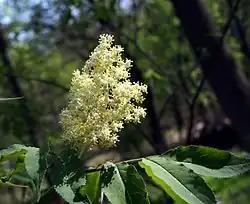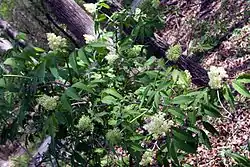Sambucus racemosa subsp. pubens
| Sambucus racemosa subsp. pubens | |
|---|---|

| |
| Sambucus racemosa subsp. pubens in flower in spring | |
.jpg)
| |
| Sambucus racemosa subsp. pubens in fruit | |
| Scientific classification | |
| Kingdom: | Plantae |
| Clade: | Tracheophytes |
| Clade: | Angiosperms |
| Clade: | Eudicots |
| Clade: | Asterids |
| Order: | Dipsacales |
| Family: | Adoxaceae |
| Genus: | Sambucus |
| Species: | |
| Subspecies: | S. r. subsp. pubens
|
| Trinomial name | |
| Sambucus racemosa subsp. pubens (Michx.) Hultén
| |
| Synonyms[1] | |
| |
Sambucus racemosa subsp. pubens, the American red elder, is a subspecies of red-berried elder (Sambucus racemosa) native to North America.[2][3] The inflorescence is a rounded panicle, making the plant easy to distinguish from the more common S. canadensis, which has a more open, flattened corymb. Some authors have considered it to be a separate species.
Uses
Common name is "American red-berried elder" or "red elderberry". The red berries are an important food source for many birds. They have a bitter taste and can cause digestive problems if eaten in large quantities by humans.[4]

References
Wikimedia Commons has media related to Sambucus racemosa subsp. pubens.
- ^ "Sambucus pubens". The Plant List.
- ^ "Sambucus racemosa subsp. pubens (Michx.) Hultén". Plants of the World Online. 2020-07-17. Retrieved 2025-02-15.
- ^ Michaux (1803). Flora Borealis-Americana. Vol. 1. p. 181.
- ^ Niering, William A.; Olmstead, Nancy C. (1985) [1979]. The Audubon Society Field Guide to North American Wildflowers (Eastern Region ed.). Knopf. p. 448. ISBN 0-394-50432-1.